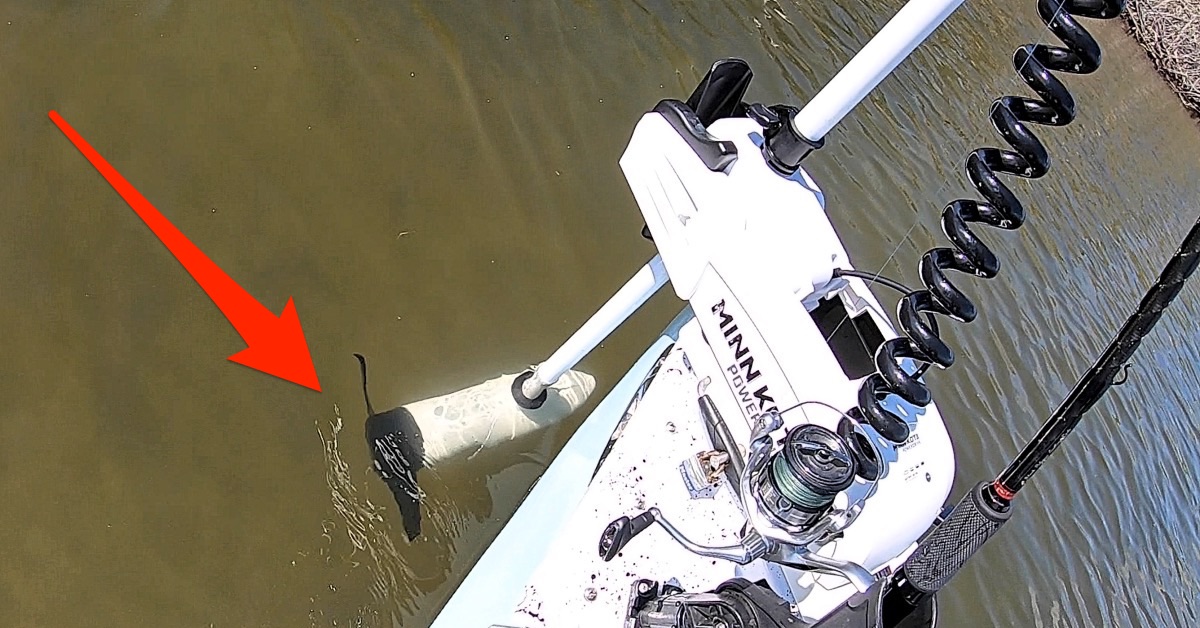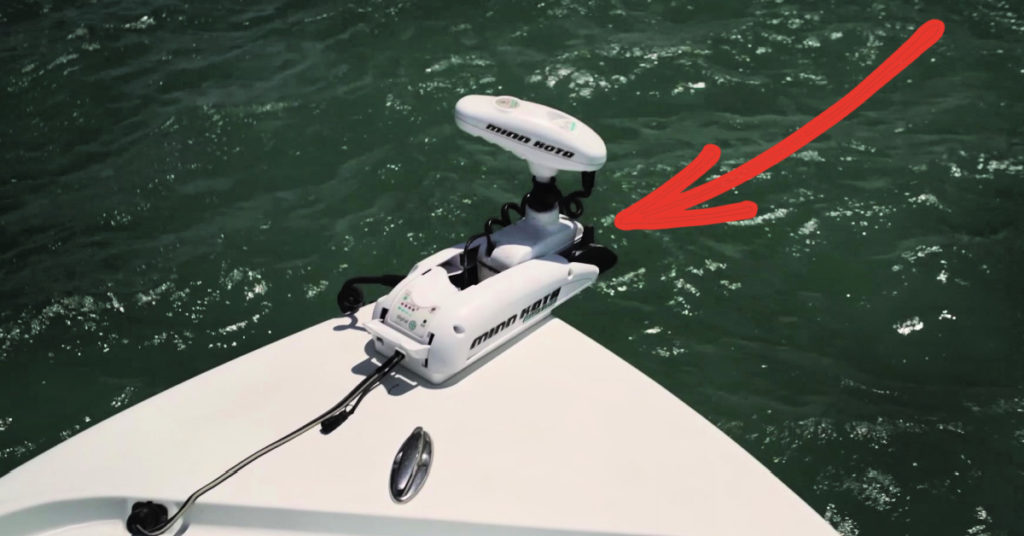Shallow Water Trolling Mistakes That Cost You Fish
- By: Tony Acevedo
- on

Note: This blog post on Shallow Water Trolling Mistakes was originally posted on June 18, 2022, but we’re sharing it with you again so you can avoid making these same mistakes this fall. Oh, and be sure to check out all of the HELPFUL comments below this article!
Stop committing these shallow water trolling mistakes out on the water!
Trolling motor mistakes are major reasons why anglers lose out on tons of fish, especially in shallow water.
Learn how you can fix these errors and catch more fish right here!!
Shallow Water Trolling Mistakes [VIDEO]

If you aren’t making the proper adjustments to your trolling motor, you risk missing out on tons of fish up in the shallows.
For this demonstration, the trolling motor I have is a Minn Kota Riptide Powerdrive (55lbs, 48″ shaft).
Mistake #1 – Depth Adjustments
The biggest mistake most commonly made by anglers is that they don’t adjust the depth at which the trolling motor is sitting.
You need to adjust the depth of your trolling motor to accommodate the depth you are fishing.
This takes a bit of playing around to get the depth just right for where you are fishing.
The objective is to have your trolling motor and its propeller just below the surface of the water.
It is critical that the prop remains under the surface and does not make a bunch of noise.
You want to have the motor as high up in the water as possible without it cavitating or creating unwanted noise.
Also, you can then get as shallow as possible without worrying about hitting or dragging the bottom.
In addition, you also should take into account the draft of your boat.
You can only go as shallow as your boat can go.
Mistake #2 – Adjust Speed Too Often
Another major mistake that is commonly made is starting and stopping the motor quite often.
If you start the trolling motor at a very high speed, you’re creating lots of unwanted disturbances in the water.
Sudden bursts in the water can easily spook fish in the shallows.
If you are stopped, be sure to turn the speed down to zero before proceeding and moving.
Then gradually increase your speed.
Mistake #3 – Moving Too Fast In The Shallows
Do not fall into the trap of moving too fast in the shallows!
You risk bumping into things you can’t see below you and you risk scaring off potentially hungry fish.
To avoid this, try keeping your trolling motor set to one standard speed.
You want to sort of crawl and not move too fast or you will miss fish.
On the flip side, you don’t want to go too slow and miss out on further spots of interest down the shoreline.
Also, when you have your trolling motor on lower speeds, you can get away with stops and starts on the water.
Bonus Tips
If you have your trolling motor set as high up as it possibly can, you do want to remain cautious of incoming waves or heavy winds.
Before those wakes and wind come through, you should turn the trolling motor prop off in case it breaches the surface.
That is an easy way to make noise and completely blow out an area with fish.
Moreover, it is also incredibly important to take weight distribution into account.
If you have your trolling motor set as high as possible and you then walk to the back of your boat, it will affect the depth positioning of the trolling motor prop.
This is critical to keep in mind when you are out on the water.
On the other hand, if you are fishing in slightly deeper water, it can be a good idea to have your motor set to a slightly lower depth.
That way you can avoid constantly readjusting it if boats or wakes pass by.
You won’t have to worry about bottoming out in deeper water.
Conclusion

The biggest takeaway here is to adjust your trolling motor in order to get the absolute most out of its use.
You would be surprised how shallow you can get with a trolling motor and remain super stealthy.
Just always pay attention to what is below you and out in front of you because the last thing you want is your trolling motor getting caught in bottom structure.
Do you have any more questions about trolling motors or how to correct these common mistakes?
Let me know your thoughts down below!!
And if you know someone who wants to learn more about the shallow water trolling mistakes, please TAG or SHARE this with them!
P.S. Want access to our best fishing spots and tips, plus discounts to our online tackle store? Click here to join us in the Insider Club!
Related Articles:
Related categories:
STOP WASTING TIME ON THE WATER!
Do what the “SMART ANGLERS” are doing and join the Insider Club.
Here’s what you’ll receive today when you join:
- Weekly fishing reports and TRENDS revealing exactly where you should fish every trip
- Weekly “spot dissection” videos that walk you through all the best spots in your area
- Exclusive fishing tips from the PROS you can’t find anywhere else
- Everything you need to start catching fish more consistently (regardless if you fish out of a boat, kayak, or land).










I figured out my typical boat draft depth and angle and marked my TM shaft to a height that puts the prop just below the lowest part of the boat hull in the water. It’s still pretty shallow but the motor would run shallower. That helps prevent me from dragging bottom. If the TM won’t go the boat won’t either. I’ll drop it in deep or rough water.
Good stuff!
If fishing in shallow water, hull slap will spook fish. I have a 19′ bay boat, and try to fish shallow water only when I can move with the waves to avoid hull slap or in calm areas. I have found that trying to fish moving against waves has two big disadvantages: higher trolling motor speeds and hull slap, which both spook the fish.
Hull slap is definitely hard to avoid. I try to sort of “zig zag” if I am going directly into chop instead of going straight into it. Will also depend on the shape of the hull of your vessel.
I have placed blue masking tape, after some trial & error, on the shaft of my MinnKota to provide a 1 ft, 2ft and 3ft (of water) reference point on where to place the top of the adjustable collar to ensure the motor isn’t going to cavitate as I move about my 16ft skiff (amazed that 225 lbs makes such an impact). The collar easily slides past (or over) the tape in either direction but may show some wear after a few weeks. I’ve also tried marking the shaft with a Sharpie but it rubs off pretty easily.
Great idea! You could also try using some sort of clear coat over the sharpie to help it last a bit longer.
Try Acrylic nail polish.
I would like to hear your thoughts on using “Spot Lock”. It took me a while to figure out how to use it without blowing out the fishing hole. In the Beaufort, SC, area we have big tide swings, resulting in a swift current. I have to bring my boat to a stop and then engage the spot lock feature. Otherwise, the trolling motor cycles to high-speed trying to reposition the boat back to the GPS point I engaged it at. Sometimes I have to turn the boat around to face the bow into the current and then engage the spot lock to avoid blowing out the fish.
Spot lock is great in deeper water, but you definitely want to make sure you come to a complete stop in shallow water before engaging it to avoid the excess noise and thrust. My old trolling motor had auto pilot, which I found to be very useful to keep my heading while I was able to keep control of the speed.
Oh yeah, I love my auto pilot! My previous trolling motor was a tiller control and I spent 80% of my time adjusting course. Very frustrating. Now I just set the heading, adjust the speed, and fish. One of my favorite features. Any subtle adjustments to course and speed are made using the key fob. A LOT easier and more relaxing.
Tony, I would love to hear more about your boat as well.
Will have a video walkthrough soon!
Tell us about your boat and setup on this video.
Will have a video walkthrough soon!
Great tips Tony! My MinnKota (manual steer) vibrates at mid to higher speeds. Any tips on reducing the vibrations? Thanks
That most likely is a balance issue with the prop. Check for any nicks or dings in the prop. If so, file or sand them out. Big gouges may be too much to repair and stay balanced. If no nicks or dings, try taping a dime to one of the blades and see if it gets worse or less. Move the dime around on both blades until the vibrations go away. If you are successful, glue the dime or a washer to the prop where the dime was.
Easy fix… buy another prop and change it out. Keep the original for emergencies, like when you shatter the prop on an oyster rake.
David gave some great tips! Also make sure the bolts that mount the motor are snug. Mine tends to vibrate more the higher I have the motor up.
There are several videos on Youtube about “tuning” a trolling motor. It can make a huge difference if you have vibrations caused by hitting something that caused the motor to shift in it’s casing.
Good to know, thanks Dave!
Yea I have done and am guilty of doing alot of those things you mentioned especially when I first started fishing inshore saltwater almost 20 years ago March of 03 to be exact and every now and then especially about using the motor on high to often I have found myself doing it especially if I’m fishing in the evening for reds and I’m trying to beat the sun also if I see alot of activity on bait up ahead and I want to get there before the fish leaves I think it all boils down to patience after all if you ever notice older people fishing that move slow anyway if they know what they are doing they always seem to catch fish when others who are in a hurry seem to miss and im not as patient as I used to be just another thing I need to work on thanks for the info and all you do😉👍
We all are definitely guilty, including myself! Starting out fishing from a kayak has definitely taught me patience, but when you have a motor you can get a little carried away.
Great discussion. Gave some really good tip I will be using on future trips
Thank you for the great feedback Joseph!
Great info, Thanks Tony.
My pleasure Mark!